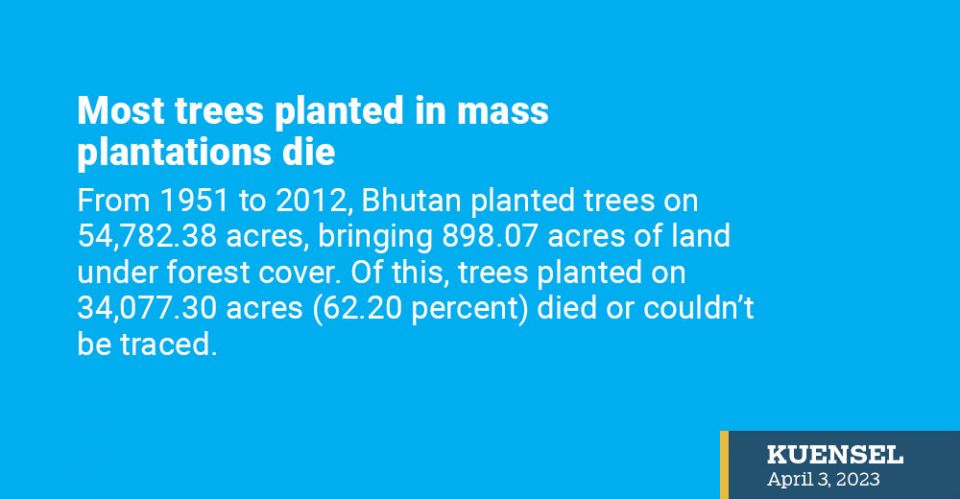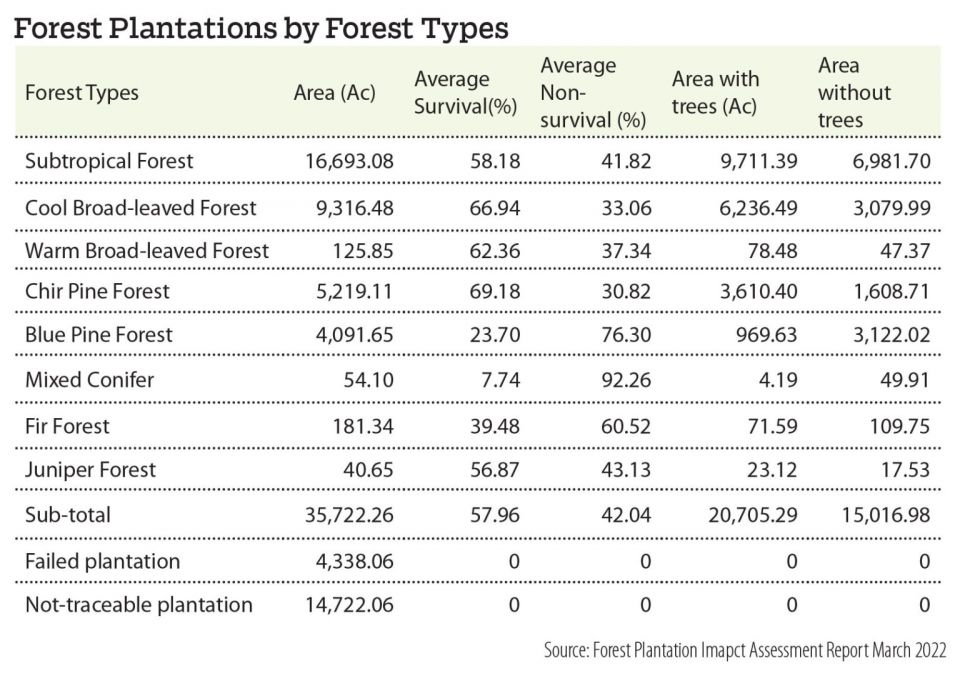
… as high as 62.2 percent of trees have failed
From 1951 to 2012, Bhutan planted trees on 54,782.38 acres, bringing 898.07 acres of land under forest cover. Of this, trees planted on 34,077.30 acres (62.20 percent) died or couldn’t be traced.
A recently published assessment report by the Department of Forests and Park Services revealed that of the total plantation, 54,782.38 acres are outside Forest Management Units (FMUs) and 1,126.04 acres are within the FMUs.
In the last 72 years, varieties of species were planted as part of afforestation, reforestation, social forestry plantation, industrial plantation, avenue plantation, and enrichment plantation.
The first forest policy of 1974, which has been replaced by the forest policy of 2011, guided the tree plantation projects. Plantations are expected to rehabilitate degraded forests, protect water catchment areas, and replenish timber reserves.
Tree plantation in the mixed conifer forest (mixture of broadleaf trees and conifers) had the lowest rate of survival at 92.26 percent followed by Blue Pine forest at 76.30 percent. Trees planted within the Chir Pine and cool-broad-leaved forests survived well.
“The average survival rate of forest plantation 57.96 percent, against the required limit of 70 percent,” the assessment report stated.
The majority of the plantations were carried out in the subtropical forest (16,693.08 acres).

The first of its kind in the country, the report pointed out that the tree plantation projects neither help boost the rural economy nor reap ecosystem services like restoration of soil and water conservation, biodiversity conservation, purification of freshwater, and habitat improvement for wildlife, among others.
The report stated that there were several reasons for the failure of tree plantation projects. For example, the lack of adequate funds for plantation maintenance, natural calamities such as landslides, floods, and forest fires, development activities, poor seedling quality, and harsh climatic conditions are some.
Those who participated in the major tree plantation project at Kuensel Phodrang in Thimphu said the planted trees lacked care and monitoring.
“Once I finished with the plantation, I never visited the site. I visited the plantation site last year and I couldn’t locate where I planted it,” a participant said.
In 2015, 100 volunteers planted 49,672 trees in an hour and set a world record. Most of the saplings did not survive mainly due to a lack of care from the volunteers. Among the surviving ones are pine saplings.
“Most of the trees planted are left to fend for themselves. They do not receive the required care. Without water, they cannot survive,” another participant said.
Some said that incentives might help people to provide aftercare to the plants once it was planted and adopted. “We lack ownership; plants die,” a participant said.
The report stated a need to review and improve the financing for the forest plantation programmes. Monitoring and evaluation with research components are crucial support areas.
The assessment also showed that trees planted in the community forests (CF) had a comparatively lower rate of survival (56.57 percent).
While 30 percent of the total number of community forests (840) reaped benefits from the CF, in the country, the remaining CFs are grappling with a shortage of funds, issues in operation, and lack of enterprise development.
“To date, we haven’t been able to benefit from the CF but look forward to changes in the future,” Bakti Maya Monger from Tsirang said in an earlier interview.
As of 2020, 48,778 acres (excluding social forestry plantation) have been brought under forest plantation in the country.












